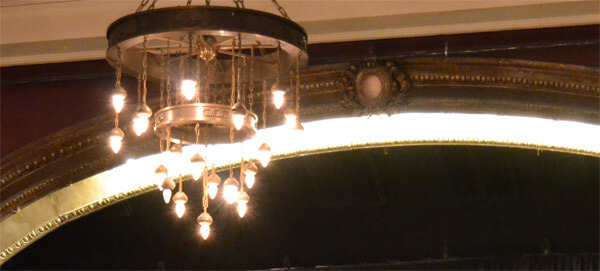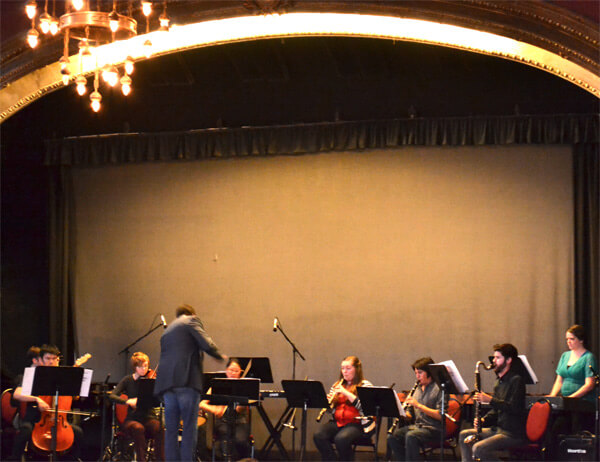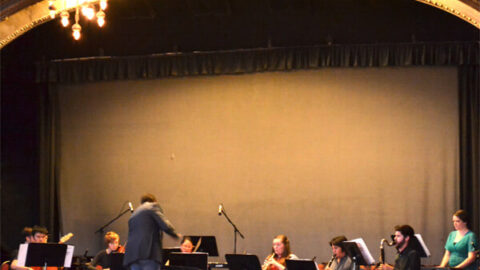 Located at the heart of Seattle’s hip Capitol Hill neighborhood, the historic Century Ballroom is the perfect example of a classic dance hall, complete with ornate chandeliers, old wooden floorboards, and red velvet stage curtains. Popular with Seattle’s social dance communities, it’s a place that’s typically associated with salsa, swing, and tango—not the classical music scene.
Located at the heart of Seattle’s hip Capitol Hill neighborhood, the historic Century Ballroom is the perfect example of a classic dance hall, complete with ornate chandeliers, old wooden floorboards, and red velvet stage curtains. Popular with Seattle’s social dance communities, it’s a place that’s typically associated with salsa, swing, and tango—not the classical music scene.
Last Friday, Seattle new music collective The Box is Empty hosted what was perhaps the venue’s first concert of contemporary classical music. The event was a convivial affair in the style of a musical salon, drawing a sizable, diverse audience for an evening of performances, libations, and conversation. The program featured the Seattle premiere of five recent works for small ensembles, including the world premiere of a piece by local composer Nat Evans.

Founded in 2011 by conductor Jeremiah Cawley, The Box is Empty is a newcomer to Seattle’s blooming new music scene. The project-based collective emphasizes engagement and community, providing performance opportunities for young professional musicians and presenting innovative concerts that welcome new audiences. Friday’s event featured sixteen local musicians, including up-and-coming soprano Maria Mannisto.
The concert began with the driving beat of Michael Gordon‘s 1988 work “Four Kings Fight Five”. Gordon, co-founder of the Bang on a Can organization, scored this piece for an ensemble of nine musicians, pitting woodwinds, strings, keyboard, and percussion against each other in an exploration of pulse and conflicting meters. Under Cawley’s baton, the ensemble gave a sizzling performance of this rhythmically complex piece. Violinist Mara Sedlins brought a deliberately harsh, raw tone to the work’s only prominent melody, a sparse, cyclic progression of notes that appears in the finale.
Seattle composer Nat Evans was on hand for the world premiere of his 2012 work “Hear No Noise”, written for soprano and chamber ensemble. Evans’ innovative pieces often involve site-specific performances and weave together acoustic, electronic, and natural elements. His work “Sunrise, September 18, 2010” invited listeners around Seattle to collectively experience the natural phenomenon of dawn while listening to a pre-recorded musical track.
Inspired by the writings of 9th century Chinese monk Han Shan, “Hear No Noise” blends instrumental and vocal sounds with a backdrop of recorded birdsong, creating a meditative soundscape. A poem by Han Shan (sung by the soprano) provides a loose structure for the piece, but the text never takes center stage. Instead, vocal and instrumental lines drift together into blots of sound, gliding by effortlessly like soft clouds floating in a calm aural sky. Light percussion sounds from a bass drum and gourd shaker gently propel the piece forward. Unfortunately, the work’s subtleties and contemplative mood were diminished by the bustling street sounds that wafted in through the ballroom’s open windows. Of the five works on the program, this would have benefited the most from a more traditional concert hall performance.
Evans’ work was followed by another world premiere. Scott Gendel‘s “For Lotte, Asleep” is a tribute to his daughter, composed in 2009 during her naps as an infant. Written for piano quintet, this three-movement work rests solidly in the Romantic chamber music tradition. Its rich melodies and lullaby imagery are charming, but Gendel’s writing rarely strays far from the same soothing mood, even between movements.
Composer Amy Beth Kirsten is known for her collaborations with new music ensemble Eighth Blackbird. Written earlier this year, her work “L’ange pâle (The Pale Angel)” uses jagged clusters of sound to create a haunting, atmospheric world. The piece features soprano voice, flute, and two identical collections of percussion instruments, including wine bottles, various drums, and goblets filled with water. Soprano Maria Mannisto exuded confidence in her reading of the difficult vocal part. Drawn from the text of a French poem, it traverses everything from sung passages to syllables that are vocalized as discrete sounds.
Cawley, Mannisto, and the ensemble closed out the evening with the U.S. premiere of “Here (In Circles)”, a work composed by Dutch multimedia artist Michel Van Der Aa in 2002. Written for soprano voice accompanied by an ensemble of winds, strings, and percussion, the piece blurs the boundaries between live and recorded music through the use of a cassette tape recorder operated by the vocal soloist.

At the start of the performance, the tinny recorded sounds emanating from the tape player were barely audible over the din of the ensemble, despite Mannisto’s efforts to hold the device close to a microphone. However, the taped audio became increasingly prominent through a combination of directions to rewind, record, and replay. At the finale, the rest of the ensemble faded away entirely, leaving Mannisto and her recorded voice stuck in a bizarre, endlessly-looping duet. It was a dramatic way to conclude a program chock full of musical innovation and creativity.
The format of Friday’s concert was a success, equally encouraging active listening and socializing over the course of the evening. During the performances, the crowd listened intently, giving the musicians their full attention. Generous intermissions between pieces encouraged mingling between performers and audience members. The Century’s bar generated a steady stream of traffic throughout the evening. Although the event lasted several hours—far longer than a typical classical music concert—no one seemed to mind. In fact, most of the crowd stuck around for another round of drinks and conversation after the music ended.
Despite taking a gamble with an unusual choice of venue and atypical concert format, Cawley and The Box is Empty scored big with Friday’s performance. The Century Ballroom provided a setting far more conducive to social interaction than the typical concert hall, resulting in a lively and enjoyable event that pleased musicians and audience alike. Let’s hope this successful experiment inspires more events of its kind, both locally and nationwide.
—
Dana Wen is a Seattle-based pianist and software engineer who writes about music, technology, and everything in between. Follow her on Twitter @wenguin.
























